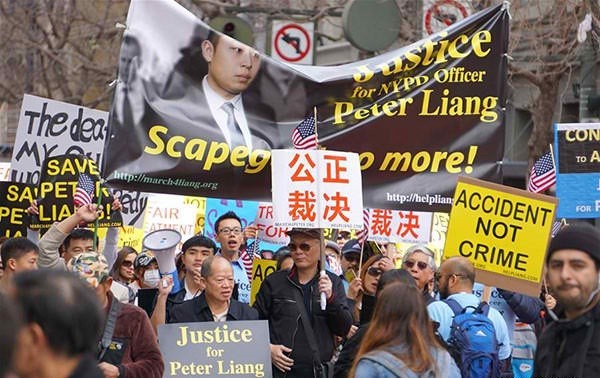Embattled former NYPD cop Peter Liang accidentally pulled the trigger which killed unarmed black man Akai Gurley. But he is now the rallying point in a new round of racial bias protests in the U.S. because of perceptions that the 28-year-old is a fall guy over past court decisions clearing white police officers with similar offenses.
The political noise raised by Liang indictment has given rise to protest rallies against the Brooklyn jury decision, finding him criminally liable for Gurley’s death. The demonstrations on Feb. 20 in New York City drew thousands of protestors, drawing a parallel to the “Black Lives Matter” rallies in 2015 over consecutive deaths of unarmed black men in the hands of white officers.
In a bizarre twist, another black man, Gurley, died, but the trigger man, is also seen by many in the U.S. and not just American Chinese as also a victim. The developments give rise to the question if migrant Chinese too should launch a “Yellow Lives Matter” campaign.
First-time observers of the protests for Liang, such as a 28-year-old Chinese PhD student in Boston, who participated for the first time in a political event, were impressed with the peaceful conduct of the rallies held at a public park.
The police was friendly, participants marched in an orderly way while shouting slogans. Global Times reported that estimates of participants number in Boston Pak at 2,000, but across the U.S. in other cities, it was 100,000 nationwide.
Most participants, though, are older migrants, while younger Chinese holding student visas hold off attending these events because they were warned by their parents not to and they fear risking the revocation of their F-1 visas.
There is apparently an issue of belongingness as Chinese students hesitate to join due to a feeling that Chinese Americans are discriminating against them, while some see the rallies as Chinese fighting for the rights of an American.
Until Liang’s case came up, Asian Americans rarely were mentioned in the national conversation on identity politics, pointed out The New York Times. The lack of engagement in political advocacy and debate is because immigrant populations “believe, rightly or wrongly, that they are on a quick march toward whiteness.”
However, Feb. 20 broke their silence and is a landmark in Asian American community as members of the yellow race rally behind Liang and other Asians who have similar encounters with black people.



























